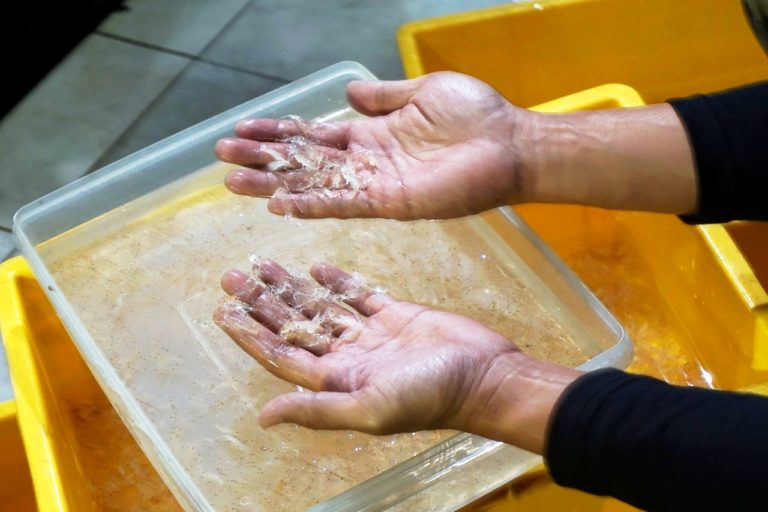- Indonesia has allowed the resumption of exports of lobster larvae and set a maximum quota for wild capture of the crustacean to control the trade.
- But fisheries experts and conservationists say the quota and requirements will not be enough to spur companies into investing in Indonesia’s lobster aquaculture sector, or to stop illegal lobster exports.
- Lobsters are among Indonesia’s top fisheries commodities, but the illegal export of larvae and baby lobsters cost the country 900 billion rupiah ($64 million) in lost revenue in 2019 alone.
- The larvae are typically sold to buyers in Vietnam, Singapore and China, where they can be raised and sold at much higher prices.
JAKARTA — Scientists and conservationists are calling for more stringent control and monitoring of Indonesia’s exports of lobster larvae to prevent smuggling.
The country’s fisheries minister, Edhy Prabowo, in May ordered the resumption of exports of baby lobsters in an effort to boost revenues from the fisheries sector. Exports had previously been banned by his predecessor, Susi Pudjiastuti, to conserve the declining wild population and tackle the illegal lobster market.
In reopening the trade, the fisheries ministry has permitted the wild harvesting of nearly 140 million lobster larvae. Seventy percent will be allocated for domestic cultivation in aquaculture farms, while the rest are for export. The ministry has also granted export permits to 18 companies, but they’re yet allowed to make any shipments until they demonstrate they can raise the lobsters in the country.
But fisheries experts and conservationists say the quota and requirements will not be enough to spur companies into investing in Indonesia’s lobster aquaculture sector, or to stop illegal lobster exports.
“On business considerations, the companies will likely be more interested in exporting than cultivation,” said Irzal Effendi, an aquaculture professor at the Bogor Institute of Agriculture (IPB). He said he was worried the requirements would be mere “formalities” for exporters to obtain permits. “They’re probably not really serious in developing the national lobster aquaculture industry.”

Lobsters are among Indonesia’s top fisheries commodities, but the illegal export of larvae and baby lobsters cost the country 900 billion rupiah ($64 million) in lost revenue in 2019 alone, according to the PPATK, the national money-laundering watchdog. The larvae are typically sold to buyers in Vietnam, Singapore and China, where they can be raised and sold at much higher prices.
IPB’s Irzal said he doubted the illegal trade would die down now that legal exports are allowed to resume. He said the higher prices that foreign buyers were willing to pay over domestic buyers would keep the export market lucrative.
“The smuggling of lobster seeds has happened for a while and been profitable,” he said. “I don’t think eradicating it will be that easy even though it’s now legalized by the new decree.”
Yonvitner, a fisheries scientist at IPB, said he was “principally opposed” to exporting lobster larvae because it was not a sustainable way of strengthening the economy or empowering the national fisheries industry. He called for an independent scientific review of the capture quota to reflect the conditions of the wild population.
In 2016, the country’s National Commission for Fisheries Resources Research (Komnas Kajiskan) reported that lobsters in six out of 11 fisheries management areas in Indonesia were overfished, while the rest were being harvested at maximum capacity.
“If the larvae are boosted for export, there’s the potential that only the exporters will reap the benefits,” Yonvitner said.

Irzal said Indonesia had much work to do in the coming years to catch up with regional rival Vietnam’s lobster aquaculture industry. That includes improving the survival rate of farmed lobsters, intensifying production, and refining the infrastructure.
A key way to achieve that, Yonvitner said, is to ensure that the foreign exchange revenue from lobster larvae exports are channeled back into developing the domestic lobster aquaculture industry.
At the same time, illegal exports need to be tackled, said Mohammad Abdi Suhufan, national coordinator of the NGO Destructive Fishing Watch (DFW) Indonesia. Between February and May this year, Indonesian authorities seized a combined 137,000 larvae in six raids, according to DFW-Indonesia. The estimated value of the seizures was 17.5 billion rupiah ($1.2 million).
DFW-Indonesia estimates that the first exports of lobster larvae should only be possible 16 to 20 months after the ministry lifted the trade ban. That’s based on a requirement that exporters must be able to demonstrate two harvests from their lobster farms before being allowed to export larvae.
“We will monitor the effectiveness of the new policy. One of the indicators is the decline in the number of cases of illegal shipment abroad of lobster larvae,” Abdi said.
FEEDBACK: Use this form to send a message to the author of this post. If you want to post a public comment, you can do that at the bottom of the page.














